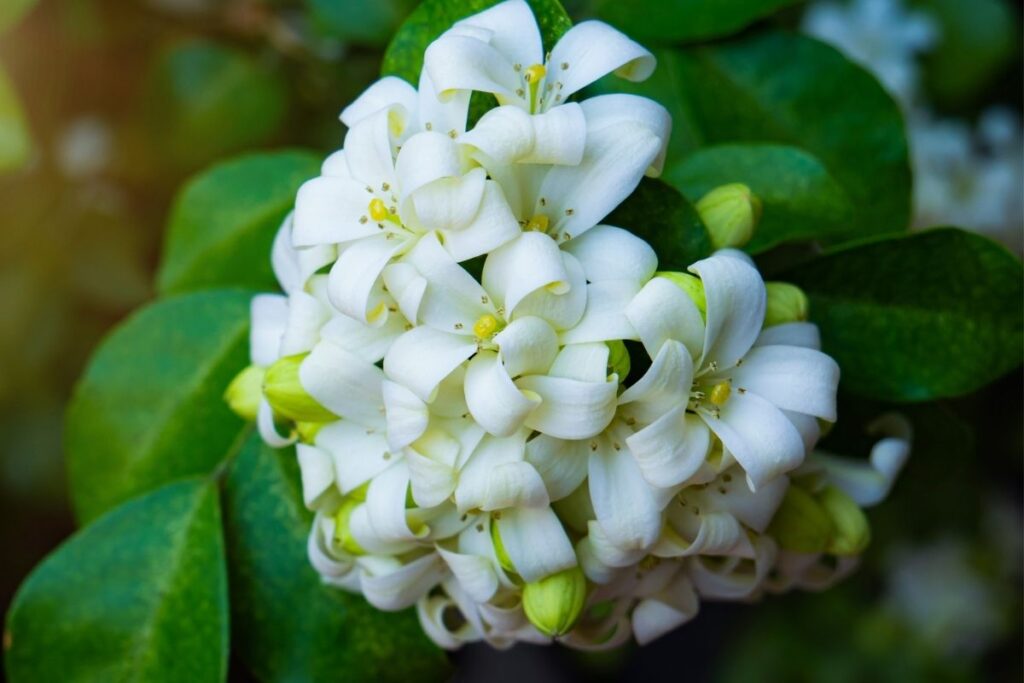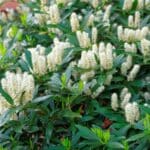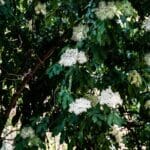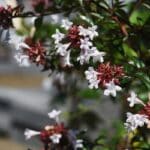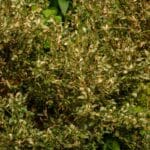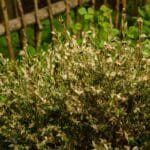Are you looking for a deliciously fragrant, showy evergreen shrub for your tropical garden? Orange jasmine (Murraya paniculata) has all these qualities and more. In this article, we’ll take a look at how to grow and care for this sweet-smelling shrub.
What Is An Orange Jasmine?
The orange jasmine (Murraya paniculata) is also known as the mock orange jasmine, orange jessamine, chalcas, or satinwood. This lovely tropical evergreen is an upright and rounded, but compact shrub of the Rutaceae family.
These plants are usually multi-stemmed but will sometimes grow as a small tree and can be trained to grow with a short single stem. (1)
The orange jasmine generally grows to 8-12ft (2.4-3.7m) high by 8-15ft (2.4-46m) wide, but in ideal conditions, this plant may grow as tall as 23ft (7m) in a tree form.
Orange jasmine is native to China, Taiwan, Nepal, India, Pakistan, and other countries of southeast Asia, as well as northern Australia. In its native range, this plant grows in rainforest and thickets (2)
This plant has beautiful glossy green leaves that are alternately arranged. If you look closely, you’ll notice that this plant actually has compound deep green leaves, consisting of 9 or more leaflets, each measuring 1-4 inches long and ½ to 2 inches wide.
Orange Jasmine Flowers
Orange jasmine flowers are wonderfully fragrant and smell like orange blossoms. The flowers tend to smell most strongly in the evenings.
The flowers, which occur in terminal clusters, can be present all year round. Each flower measures about ⅞ inch (2.2cm )across and has 5, or sometimes 4, cream-white petals.
Small fleshy red fruits are produced after flowering, with each berry measuring up to about half an inch (13mm) in size.
How To Grow An Orange Jasmine Shrub
The best way to grow orange jasmine is from seed, sown in spring. Growing this plant from stem tip cuttings taken in summer is also possible.
These jasmine plants can be grown in various soil types, but moist, well drained soil with an acidic to neutral pH is the best option. This plant will also grow best in a rich substrate with plenty of organic material. (3) In waterlogged soil or muddy soil, orange jasmine does not thrive.
Although the species is said to have a high tolerance for drought, it should nevertheless be kept well watered in drier climates. It should also be remembered that orange jasmine plants grown in pots and containers will require more frequent watering because the soil drys out faster.
Being forest plants, orange jasmines are adapted to growth in the understory where they get partial or dappled shade. The hot, direct sunlight must be avoided by orange jasmine plants. Recreate these conditions at home to get the most out of your plant.
These plants can be grown in USDA zones 9b -11, although they prefer warmer environments and will do better in zone 10 and 11. In those zones, they will be fast-growing when young, but slow down as they mature.
Care And Maintenance
This tropical plant has a fast growth rate and may need to be pruned often when young if a neat hedge or rounded shape is desired. It is best to trim this plant lightly and after it has flowered.
If grown in nutrient-poor soil, or a container, feeding your orange jasmine with a good evergreen shrub fertilizer will help to keep it growing well.
These bushes are known to be relatively pest-resistant but they may be affected by nematodes, scales, sooty mold, and whiteflies.
Uses
Horticultural Uses
Orange jasmine has many uses in the garden. This plant can be sheared into a formal hedge or screen. Space your plants 3-4 feet (0.9-1.2m) apart for a neat and attractive hedge.
This orange jasmine plant will also make a handsome specimen tree if pruned and trained to grow with a single stem and upright form. The orange jasmine makes a fine indoor plant for containers, provided it is grown in a fairly sunny area in the home.
Human Uses
This bush has plenty of traditional medicinal uses including the treatment of stomach and abdominal pain, headaches, and diarrhea. This plant has also been used in traditional dishes in India and Malaysia. (2)
Wildlife Uses
The bright reddish orange berries of this plant attract fruit-eating birds which distribute the seeds. The sweet-smelling flowers attract honey bees.
FAQs
Is orange jasmine the same as jasmine?
Orange Jasmine (Murraya paniculata) is not the same as common jasmine (Jasminum spp.). While both belong to the same order, they are different plant species with distinct characteristics.
What does orange jasmine smell like?
Orange jasmine has a sweet smell and fragrant aroma similar to orange blossoms. The scent is often described as a mix of citrus and jasmine, contributing to its common name.
Can we eat orange jasmine?
No, Orange Jasmine is not typically consumed as a food item. While some plants are named for their scent rather than edibility, it’s crucial to verify the safety and edibility of any plant before considering consumption.
Why is it called orange jasmine?
The name “orange jasmine” likely originates from the plant’s fragrant white flowers, which emit a scent reminiscent of both oranges and jasmine. The common name emphasizes the plant’s aromatic qualities rather than any direct relation to the true jasmine plant.
Conclusion
The orange jasmine is a great plant for gardens in warm to tropical gardens, where it will produce attractive foliage, showy flowers, and sweet orange blossom fragrances. This plant has a variety of uses ranging from specimen planting to formal hedging. Be sure to consider this shrub for your next gardening project!
See more about genus Jasminum and jasmine flower meaning.
*image by [email protected]/depositphotos
References
References
- Gilman, E. F. Murraya paniculata. Fact sheet fps-416. University of Florida Co-operative Extension Service.
http://hort.ufl.edu/database/documents/pdf/shrub_fact_sheets/murpana.pdf
- Dosoky, N. S., Satyal, P., Setzer, W. N. & Gautam, T. P. Composition and Biological Activities of Murraya paniculata (L.) Jack Essential Oil from Nepal.
https://www.mdpi.com/2305-6320/3/1/7/pdf
- Brickell, C. Encyclopedia of Plants & Flowers. American Horticultural Society.
Close

